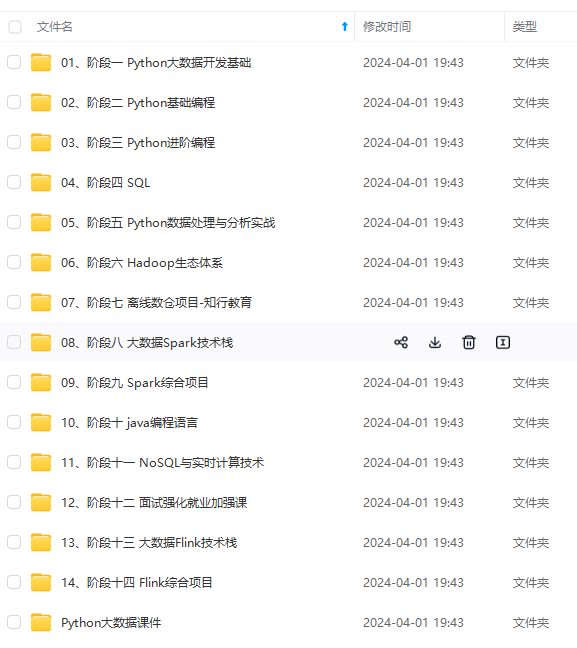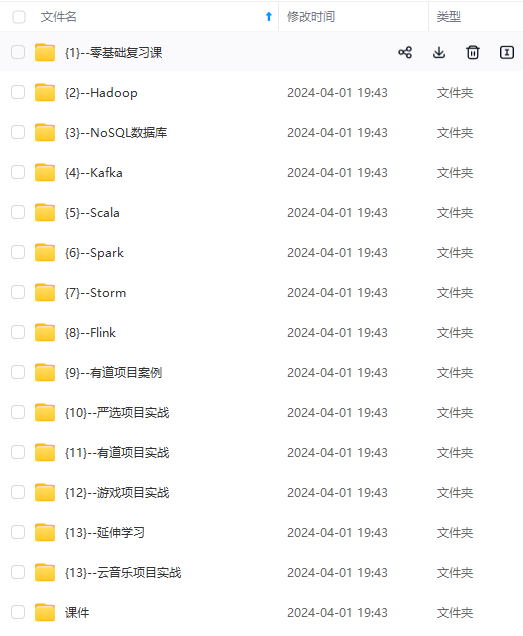

网上学习资料一大堆,但如果学到的知识不成体系,遇到问题时只是浅尝辄止,不再深入研究,那么很难做到真正的技术提升。
一个人可以走的很快,但一群人才能走的更远!不论你是正从事IT行业的老鸟或是对IT行业感兴趣的新人,都欢迎加入我们的的圈子(技术交流、学习资源、职场吐槽、大厂内推、面试辅导),让我们一起学习成长!
6.5,2.8,4.6,1.5,Versicolor
5.6,2.7,4.2,1.3,Versicolor
6.3,3.4,5.6,2.4,Virginical
4.9,3.1,1.5,0.1,Setosa
6.8,2.8,4.8,1.4,Versicolor
5.7,2.8,4.5,1.3,Versicolor
6.0,2.7,5.1,1.6,Versicolor
5.0,3.5,1.3,0.3,Setosa
6.5,3.0,5.2,2.0,Virginical
6.1,2.8,4.7,1.2,Versicolor
5.1,3.5,1.4,0.3,Setosa
4.6,3.1,1.5,0.2,Setosa
6.5,3.0,5.8,2.2,Virginical
4.6,3.4,1.4,0.3,Setosa
4.6,3.2,1.4,0.2,Setosa
7.7,2.8,6.7,2.0,Virginical
5.9,3.2,4.8,1.8,Versicolor
5.1,3.8,1.6,0.2,Setosa
4.9,3.0,1.4,0.2,Setosa
4.9,2.4,3.3,1.0,Versicolor
4.5,2.3,1.3,0.3,Setosa
5.8,2.7,4.1,1.0,Versicolor
5.0,3.4,1.6,0.4,Setosa
5.2,3.4,1.4,0.2,Setosa
5.3,3.7,1.5,0.2,Setosa
5.0,3.6,1.4,0.2,Setosa
5.6,2.9,3.6,1.3,Versicolor
4.8,3.1,1.6,0.2,Setosa
6.3,2.7,4.9,1.8,Virginical
5.7,2.8,4.1,1.3,Versicolor
5.0,3.0,1.6,0.2,Setosa
6.3,3.3,6.0,2.5,Virginical
5.0,3.5,1.6,0.6,Setosa
5.5,2.6,4.4,1.2,Versicolor
5.7,3.0,4.2,1.2,Versicolor
4.4,2.9,1.4,0.2,Setosa
4.8,3.0,1.4,0.1,Setosa
5.5,2.4,3.7,1.0,Versicolor
### 探索思路
这里只是简单示例, 目的在于熟悉 Spark 中的随机森林回归使用方法, 无任何投资引导。
**目标**:
通过 `SepalLength(花萼长度)`, `SepalWidth(花萼宽度)`, `PetalLength(花瓣长度)`, `PetalWidth(花瓣宽度)` 预测 `Iris(鸢尾花)` 的 `Species(品种)`。
**标签**:
由于 `Iris(鸢尾花)` 的 `Species(品种)` 是 `字符串(String)` 的形式, 本例将使用 `pyspark.ml` 的 `StringIndexer` 模块将 `Iris(鸢尾花)` 的 `Species(品种)` 索引化。
### 导入 pyspark.sql 相关模块
Spark SQL 是用于结构化数据处理的 Spark 模块。它提供了一种成为 DataFrame 编程抽象, 是由 SchemaRDD 发展而来。
不同于 SchemaRDD 直接继承 RDD, DataFrame 自己实现了 RDD 的绝大多数功能。
from pyspark.sql import Row, SparkSession
from pyspark.sql.functions import col
from pyspark.sql.types import StringType, DoubleType
### 导入 pyspark.ml 相关模块
Spark 在核心数据抽象 RDD 的基础上, 支持 4 大组件, 其中机器学习占其一。
进一步的, Spark 中实际上支持两个机器学习模块, MLlib 和 ML, 区别在于前者主要是基于 RDD 数据结构, 当前处于维护状态; 而后者则是 DataFrame 数据结构, 支持更多的算法, 后续将以此为主进行迭代。
所以, 在实际应用中优先使用 ML 子模块。
Spark 的 ML 库与 Python 中的另一大机器学习库 Sklearn 的关系是: Spark 的 ML 库支持大部分机器学习算法和接口功能, 虽远不如 Sklearn 功能全面, 但主要面向分布式训练, 针对大数据。
而 Sklearn 是单点机器学习算法库, 支持几乎所有主流的机器学习算法, 从样例数据, 特征选择, 模型选择和验证, 基础学习算法和集成学习算法, 提供了机器学习一站式解决方案, 但仅支持并行而不支持分布式。
from pyspark.ml.feature import StringIndexer, VectorAssembler
from pyspark.ml.regression import RandomForestRegressor
from pyspark.ml.evaluation import RegressionEvaluator
### 创建 SparkSession 对象
Spark 2.0 以上版本的 spark-shell 在启动时会自动创建一个名为 spark 的 SparkSession 对象。
当需要手工创建时, SparkSession 可以由其伴生对象的 builder 方法创建出来。
spark = SparkSession.builder.master(“local[*]”).appName(“spark”).getOrCreate()
### 使用 Spark 构建 DataFrame 数据 (Optional)
当数据量较小时, 可以使用该方法手工构建 DataFrame 数据。
构建数据行 Row (以前 5 行为例):
Row(SepalLength=6.4, SepalWidth=2.8, PetalLength=5.6, PetalWidth=2.2, Species=“Virginical”)
Row(SepalLength=5.0, SepalWidth=2.3, PetalLength=3.3, PetalWidth=1.0, Species=“Versicolor”)
Row(SepalLength=4.9, SepalWidth=2.5, PetalLength=4.5, PetalWidth=1.7, Species=“Virginical”)
Row(SepalLength=4.9, SepalWidth=3.1, PetalLength=1.5, PetalWidth=0.1, Species=“Setosa”)
Row(SepalLength=5.7, SepalWidth=3.8, PetalLength=1.7, PetalWidth=0.3, Species=“Setosa”)
将构建好的数据行 Row 加入列表 (以前 5 行为例):
Data_Rows = [
Row(SepalLength=6.4, SepalWidth=2.8, PetalLength=5.6, PetalWidth=2.2, Species=“Virginical”),
Row(SepalLength=5.0, SepalWidth=2.3, PetalLength=3.3, PetalWidth=1.0, Species=“Versicolor”),
Row(SepalLength=4.9, SepalWidth=2.5, PetalLength=4.5, PetalWidth=1.7, Species=“Virginical”),
Row(SepalLength=4.9, SepalWidth=3.1, PetalLength=1.5, PetalWidth=0.1, Species=“Setosa”),
Row(SepalLength=5.7, SepalWidth=3.8, PetalLength=1.7, PetalWidth=0.3, Species=“Setosa”)
]
生成 DataFrame 数据框 (以前 5 行为例):
SDF = spark.createDataFrame(data=Data_Rows)
输出 DataFrame 数据框 (以前 5 行为例):
print(“[Message] Builded Spark DataFrame:”)
SDF.show(3)
输出:
[Message] Builded Spark DataFrame:
±----------±---------±----------±---------±---------+
|SepalLength|SepalWidth|PetalLength|PetalWidth| Species|
±----------±---------±----------±---------±---------+
| 6.4| 2.8| 5.6| 2.2|Virginical|
| 5.0| 2.3| 3.3| 1.0|Versicolor|
| 4.9| 2.5| 4.5| 1.7|Virginical|
| 4.9| 3.1| 1.5| 0.1| Setosa|
| 5.7| 3.8| 1.7| 0.3| Setosa|
±----------±---------±----------±---------±---------+
only showing top 3 rows
### 使用 Spark 读取 CSV 数据
调用 SparkSession 的 .read 方法读取 CSV 数据:
其中 .option 是读取文件时的选项, 左边是 “键(Key)”, 右边是 “值(Value)”, 例如 .option(“header”, “true”) 与 {header = “true”} 类同。
SDF = spark.read.option(“header”, “true”).option(“encoding”, “utf-8”).csv(“file:///D:\Iris_Dataset_120_2023-12-30.csv”)
输出 DataFrame 数据框:
print(“[Message] Readed CSV File: D:\Iris_Dataset_120_2023-12-30.csv”)
SDF.show()
输出:
[Message] Readed CSV File: D:\Iris_Dataset_120_2023-12-30.csv
±----------±---------±----------±---------±---------+
|SepalLength|SepalWidth|PetalLength|PetalWidth| Species|
±----------±---------±----------±---------±---------+
| 6.4| 2.8| 5.6| 2.2|Virginical|
| 5.0| 2.3| 3.3| 1.0|Versicolor|
| 4.9| 2.5| 4.5| 1.7|Virginical|
| 4.9| 3.1| 1.5| 0.1| Setosa|
| 5.7| 3.8| 1.7| 0.3| Setosa|
| 4.4| 3.2| 1.3| 0.2| Setosa|
| 5.4| 3.4| 1.5| 0.4| Setosa|
| 6.9| 3.1| 5.1| 2.3|Virginical|
| 6.7| 3.1| 4.4| 1.4|Versicolor|
| 5.1| 3.7| 1.5| 0.4| Setosa|
| 5.2| 2.7| 3.9| 1.4|Versicolor|
| 6.9| 3.1| 4.9| 1.5|Versicolor|
| 5.8| 4.0| 1.2| 0.2| Setosa|
| 5.4| 3.9| 1.7| 0.4| Setosa|
| 7.7| 3.8| 6.7| 2.2|Virginical|
| 6.3| 3.3| 4.7| 1.6|Versicolor|
| 6.8| 3.2| 5.9| 2.3|Virginical|
| 7.6| 3.0| 6.6| 2.1|Virginical|
| 6.4| 3.2| 5.3| 2.3|Virginical|
| 5.7| 4.4| 1.5| 0.4| Setosa|
±----------±---------±----------±---------±---------+
only showing top 20 rows
### 转换 Spark 中 DateFrame 各列数据类型
通常情况下, 为了避免计算出现数据类型的错误, 都需要重新转换一下数据类型。
转换 Spark 中 DateFrame 数据类型。
SDF = SDF.withColumn(“SepalLength”, col(“SepalLength”).cast(DoubleType()))
SDF = SDF.withColumn(“SepalWidth”, col(“SepalWidth”).cast(DoubleType()))
SDF = SDF.withColumn(“PetalLength”, col(“PetalLength”).cast(DoubleType()))
SDF = SDF.withColumn(“PetalWidth”, col(“PetalWidth”).cast(DoubleType()))
SDF = SDF.withColumn(“Species”, col(“Species”).cast(StringType()))
输出 Spark 中 DataFrame 字段和数据类型。
print(“[Message] Changed Spark DataFrame Data Type:”)
SDF.printSchema()
输出:
[Message] Changed Spark DataFrame Data Type:
root
|-- SepalLength: double (nullable = true)
|-- SepalWidth: double (nullable = true)
|-- PetalLength: double (nullable = true)
|-- PetalWidth: double (nullable = true)
|-- Species: string (nullable = true)
### 字符串索引化 (StringIndexer) 转换 Species 列
StringIndexer (字符串-索引变换) 是一个估计器, 是将字符串列编码为标签索引列。索引位于 `[0, numLabels)`, 按标签频率排序, 频率最高的排 0, 依次类推, 因此最常见的标签获取索引是 0。
使用 StringIndexer 转换 Species 列。
MyStringIndexer = StringIndexer(inputCol=“Species”, outputCol=“SpeciesIdx”)
拟合并转换数据。
IndexedSDF = MyStringIndexer.fit(SDF).transform(SDF)
输出 StringIndexer 的转换效果。
print(“[Message] The Effect of StringIndexer:”)
IndexedSDF.show()
输出:
[Message] The Effect of StringIndexer:
±----------±---------±----------±---------±---------±---------+
|SepalLength|SepalWidth|PetalLength|PetalWidth| Species|SpeciesIdx|
±----------±---------±----------±---------±---------±---------+
| 6.4| 2.8| 5.6| 2.2|Virginical| 1.0|
| 5.0| 2.3| 3.3| 1.0|Versicolor| 2.0|
| 4.9| 2.5| 4.5| 1.7|Virginical| 1.0|
| 4.9| 3.1| 1.5| 0.1| Setosa| 0.0|
| 5.7| 3.8| 1.7| 0.3| Setosa| 0.0|
| 4.4| 3.2| 1.3| 0.2| Setosa| 0.0|
| 5.4| 3.4| 1.5| 0.4| Setosa| 0.0|
| 6.9| 3.1| 5.1| 2.3|Virginical| 1.0|
| 6.7| 3.1| 4.4| 1.4|Versicolor| 2.0|
| 5.1| 3.7| 1.5| 0.4| Setosa| 0.0|
| 5.2| 2.7| 3.9| 1.4|Versicolor| 2.0|
| 6.9| 3.1| 4.9| 1.5|Versicolor| 2.0|
| 5.8| 4.0| 1.2| 0.2| Setosa| 0.0|
| 5.4| 3.9| 1.7| 0.4| Setosa| 0.0|
| 7.7| 3.8| 6.7| 2.2|Virginical| 1.0|
| 6.3| 3.3| 4.7| 1.6|Versicolor| 2.0|
| 6.8| 3.2| 5.9| 2.3|Virginical| 1.0|
| 7.6| 3.0| 6.6| 2.1|Virginical| 1.0|
| 6.4| 3.2| 5.3| 2.3|Virginical| 1.0|
| 5.7| 4.4| 1.5| 0.4| Setosa| 0.0|
±----------±---------±----------±---------±---------±---------+
only showing top 20 rows
### 提取 标签(Label)列 和 特征向量(Features)列
在创建特征向量(Features)列时, 将会用到 VectorAssembler 模块, VectorAssembler 将多个特征合并为一个特征向量。
**提取 标签(Label) 列**:
将 SpeciesIdx 列复制为 Label 列。
NewSDF = IndexedSDF.withColumn(“Label”, col(“SpeciesIdx”))
**创建 特征向量(Features) 列**:
VectorAssembler 将多个特征合并为一个特征向量。
FeaColsName:list = [“SepalLength”, “SepalWidth”, “PetalLength”, “PetalWidth”]
MyAssembler = VectorAssembler(inputCols=FeaColsName, outputCol=“Features”)
创建 特征向量(Features) 列: 拟合数据 (可选, 如果在模型训练时使用 Pipeline, 则无需在此步骤拟合数据, 当然也就无法在此步骤预览数据)。
AssembledSDF = MyAssembler.transform(NewSDF)
**输出预览**:
print(“[Message] Assembled Label and Features for RandomForestRegressor:”)
AssembledSDF.show()
预览:
[Message] Assembled for RandomForestRegressor:
±----------±---------±----------±---------±---------±---------±----±----------------+
|SepalLength|SepalWidth|PetalLength|PetalWidth| Species|SpeciesIdx|Label| Features|
±----------±---------±----------±---------±---------±---------±----±----------------+
| 6.4| 2.8| 5.6| 2.2|Virginical| 1.0| 1.0|[6.4,2.8,5.6,2.2]|
| 5.0| 2.3| 3.3| 1.0|Versicolor| 2.0| 2.0|[5.0,2.3,3.3,1.0]|
| 4.9| 2.5| 4.5| 1.7|Virginical| 1.0| 1.0|[4.9,2.5,4.5,1.7]|
| 4.9| 3.1| 1.5| 0.1| Setosa| 0.0| 0.0|[4.9,3.1,1.5,0.1]|
| 5.7| 3.8| 1.7| 0.3| Setosa| 0.0| 0.0|[5.7,3.8,1.7,0.3]|
| 4.4| 3.2| 1.3| 0.2| Setosa| 0.0| 0.0|[4.4,3.2,1.3,0.2]|
| 5.4| 3.4| 1.5| 0.4| Setosa| 0.0| 0.0|[5.4,3.4,1.5,0.4]|
| 6.9| 3.1| 5.1| 2.3|Virginical| 1.0| 1.0|[6.9,3.1,5.1,2.3]|
| 6.7| 3.1| 4.4| 1.4|Versicolor| 2.0| 2.0|[6.7,3.1,4.4,1.4]|
| 5.1| 3.7| 1.5| 0.4| Setosa| 0.0| 0.0|[5.1,3.7,1.5,0.4]|
| 5.2| 2.7| 3.9| 1.4|Versicolor| 2.0| 2.0|[5.2,2.7,3.9,1.4]|
| 6.9| 3.1| 4.9| 1.5|Versicolor| 2.0| 2.0|[6.9,3.1,4.9,1.5]|
| 5.8| 4.0| 1.2| 0.2| Setosa| 0.0| 0.0|[5.8,4.0,1.2,0.2]|
| 5.4| 3.9| 1.7| 0.4| Setosa| 0.0| 0.0|[5.4,3.9,1.7,0.4]|
| 7.7| 3.8| 6.7| 2.2|Virginical| 1.0| 1.0|[7.7,3.8,6.7,2.2]|
| 6.3| 3.3| 4.7| 1.6|Versicolor| 2.0| 2.0|[6.3,3.3,4.7,1.6]|
| 6.8| 3.2| 5.9| 2.3|Virginical| 1.0| 1.0|[6.8,3.2,5.9,2.3]|
| 7.6| 3.0| 6.6| 2.1|Virginical| 1.0| 1.0|[7.6,3.0,6.6,2.1]|
| 6.4| 3.2| 5.3| 2.3|Virginical| 1.0| 1.0|[6.4,3.2,5.3,2.3]|
| 5.7| 4.4| 1.5| 0.4| Setosa| 0.0| 0.0|[5.7,4.4,1.5,0.4]|
±----------±---------±----------±---------±---------±---------±----±----------------+
only showing top 20 rows
### 训练 随机森林回归(RandomForestRegressor) 模型
**将数据集划分为 “训练集” 和 “测试集”**:
(TrainingData, TestData) = AssembledSDF.randomSplit([0.8, 0.2], seed=42)
**创建 随机森林回归(RandomForestRegressor)**:
RFR = RandomForestRegressor(featuresCol=“Features”, labelCol=“Label”)
**创建 Pipeline (可选)**:
创建 Pipeline, 将特征向量转换和随机森林回归模型组合在一起
注意: 如果要使用 Pipeline, 则在创建 特征向量(Features)列 的时候不需要拟合数据, 否则会报 “Output column Features already exists.” 的错误。
MyPipeline = Pipeline(stages=[MyAssembler, RFR])
**训练 随机森林回归(RandomForestRegressor) 模型**:
如果在创建 特征向量(Features)列 的时候已经拟合数据:
训练模型 (普通模式)。
Model = RFR.fit(TrainingData)
如果在创建 特征向量(Features)列 的时候没有拟合数据:
训练模型 (Pipeline 模式)。
Model = MyPipeline.fit(TrainingData)
### 使用 随机森林回归(RandomForestRegressor) 模型预测数据



**既有适合小白学习的零基础资料,也有适合3年以上经验的小伙伴深入学习提升的进阶课程,涵盖了95%以上大数据知识点,真正体系化!**
**由于文件比较多,这里只是将部分目录截图出来,全套包含大厂面经、学习笔记、源码讲义、实战项目、大纲路线、讲解视频,并且后续会持续更新**
**[需要这份系统化资料的朋友,可以戳这里获取](https://bbs.csdn.net/topics/618545628)**
tures)列 的时候没有拟合数据:
训练模型 (Pipeline 模式)。
Model = MyPipeline.fit(TrainingData)
### 使用 随机森林回归(RandomForestRegressor) 模型预测数据
[外链图片转存中...(img-Jqsl3G0z-1715623113551)]
[外链图片转存中...(img-wDJHIc3W-1715623113551)]
[外链图片转存中...(img-KogLWoXF-1715623113552)]
**既有适合小白学习的零基础资料,也有适合3年以上经验的小伙伴深入学习提升的进阶课程,涵盖了95%以上大数据知识点,真正体系化!**
**由于文件比较多,这里只是将部分目录截图出来,全套包含大厂面经、学习笔记、源码讲义、实战项目、大纲路线、讲解视频,并且后续会持续更新**
**[需要这份系统化资料的朋友,可以戳这里获取](https://bbs.csdn.net/topics/618545628)**






















 445
445











 被折叠的 条评论
为什么被折叠?
被折叠的 条评论
为什么被折叠?








